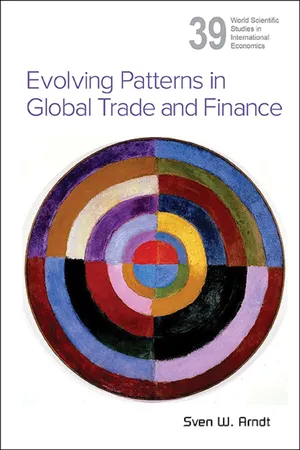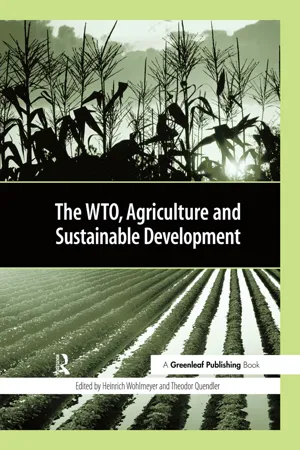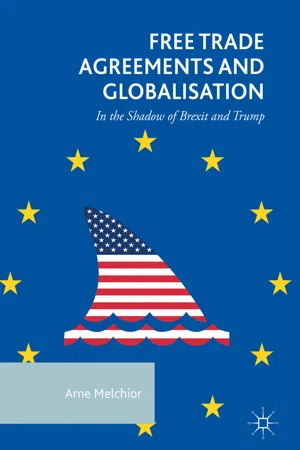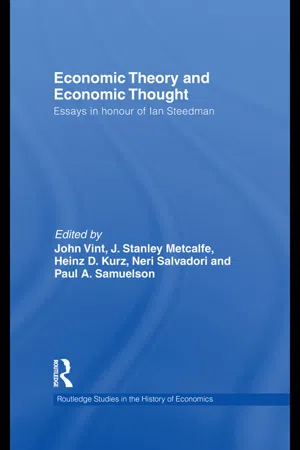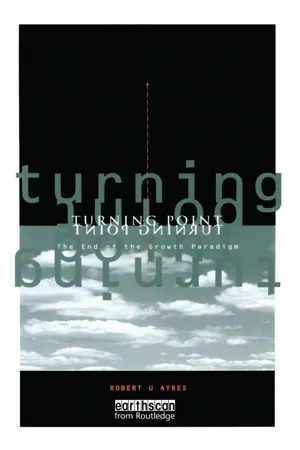Economics
Standard Trade Model
The Standard Trade Model is a theoretical framework used to analyze international trade patterns and the distribution of income. It assumes perfect competition, constant returns to scale, and identical production technologies across countries. The model helps to explain the gains from trade, the impact of trade policies, and the patterns of specialization and trade between countries.
Written by Perlego with AI-assistance
Related key terms
Related key terms
1 of 4
Related key terms
1 of 3
8 Key excerpts on "Standard Trade Model"
- eBook - ePub
International Trade
New Patterns of Trade, Production and Investment
- Nigel Grimwade(Author)
- 2020(Publication Date)
- Routledge(Publisher)
Chapter 2 Basic Theories of International Trade CHAPTER OUTLINES: Introduction. Classical Theories of Trade - absolute advantage, comparative advantage, the empirical evidence. The Terms of Trade. The Factor Proportions, Heckscher-Ohlin Theory of Trade - the Leontieff Paradox, other empirical evidence. Increasing Opportunity Costs. Indifference Curves. General Equilibrium. The Factor Price Equalisation Theorem. Demand-Side Theories of Trade. Economies of Scale. Technology-Based Theories of Trade - technology-gap trade, the product life-cycle model of trade. The Case of Monopoly. Conclusion. Introduction Why do countries engage in trade? What benefits does trade bring to countries? What products will a country export and what will it import? What determines the pattern of its trade? And, since trade is the result of specialisation, what determines the products in which a country specialises? Moreover, how does a country's pattern of specialisation and trade change over time? These are some of the questions which have pre-occupied trade theorists for over two centuries. In this chapter, we shall identify some of the theories which economists have developed (and the various theoretical tools which they have used in the process) in an attempt to answer these questions. This chapter is primarily concerned with the basic or more conventional theories which set out the gains which countries can expect from specialising in those activities in which they are relatively efficient. These constitute necessary 'building blocks' for understanding the more esoteric models which have been developed in recent years, which take into account some of the complexities of trade in today's world. These newer trade theories are not considered until Chapter 3. Usually, the term 'conventional' is restricted to the theory of trade expounded by the Classical and Neo-Classical schools of economic thought - eBook - ePub
Neoliberalism
A Critical Reader
- Alfredo Saad-Filho, Deborah Johnston, Alfredo Saad-Filho, Deborah Johnston(Authors)
- 2004(Publication Date)
- Pluto Press(Publisher)
While the preceding assumptions are necessary to make the story work, they are not sufficient. We also need to consider the implications for employment. Countries exposed to trade may lose jobs in some sectors and gain them in others. Some firms may prosper, while others may go out of existence. None of this excludes the possibility of overall job losses in the countries involved. So we need something more. Standard theory solves this problem by assuming that competitive markets automatically provide jobs for all who desire them. When this is carried over to trade theory, it ensures that the international adjustments will not lead to any overall job losses, because those who lose one job are presumed to find another. This is the third pillar of the conventional theory of international trade.To summarise. Standard trade theory relies on three claims. First, that any deficit in a nation’s trade would provoke a fall in its export prices relative to its import prices, i.e. a fall in its terms of trade. Second, that such a fall would increase the money value of exports relative to that of imports, i.e. would improve the trade balance. This requires the relative physical ratio of exports to imports to rise more than the fall in relative price of exports to imports, i.e. that the ‘elasticities’ be propitious. And third, that once the dust has settled, no nation would suffer overall job losses from international trade. These three propositions constitute the neoclassical theory of comparative cost advantage. They collectively imply that nations will always gain from international trade.It is important to distinguish between the theory of comparative cost advantage and the theory of comparative factor advantage. The two are often confused, although they are conceptually distinct. The theory of comparative cost advantage implies that international trade between nations will settle at balanced trade with no departure from full employment in both nations. Even if one of the nations had absolutely lower costs when trade opened, and was therefore able to run an initial trade surplus, the theory of comparative costs says that free trade would automatically eliminate this initial superiority. To understand what this implies, suppose that when trade opened we were to rank all industries in the surplus nation according to their degree of absolute cost advantage over their foreign competitors. Then, for free trade automatically to erode the trade surplus, the industries with the least initial absolute advantage would be the first to lose their cost advantage (we will shortly return to the mechanism proposed by the theory). This would have to be repeated on the survivors, until the tide of red ink had proceeded sufficiently far up the chain to make the initial trade surplus disappear altogether. The final survivors would then be from those industries at the top of the chain, i.e. from those with the greatest initial ‘comparative’ cost advantage. Obviously, the reverse would hold for the country whose initial absolute inferiority in trade led it to begin with a trade deficit. Here, the most favoured would be the industries with the least initial comparative cost dis - eBook - ePub
- B. N. Ghosh(Author)
- 2001(Publication Date)
- Routledge(Publisher)
7 The pure theory of international trade, globalization, growth and sustainable development: Agenda for the future
M.R. Aggarwal
Introduction: the historical perspective
The pure theory of international trade, as expounded by classical, neoclassical, and modern economists, seeks to provide an explanation of the factors, originating both from demand and supply side which tend to influence the observed pattern of trade flows and specialization among nations, and their welfare implications measured in terms of Pareto optimality, for each of the trading partners and for the world as a whole. The principle of comparative advantage was developed by Torrens (1808) and used by Ricardo (1817) to explain the pattern of trade and the benefits flowing from free trade and competition. Ricardo argues that trade between countries arises because of the relative differences in the pre-trade prices of the goods, on the assumption that the relative production costs of goods and hence relative prices (PX /PY ) in a closed economy, under competitive equilibrium conditions in both commodity and factor markets and a simple production function with the single input and constant returns, are entirely determined by relative labour inputs (LX /LY ), i.e.:and the differences in the pre-trade domestic price ratios of the goods and the comparative advantage and disadvantage, in costs between countries will be mainly due to differences in relative labour productivity. The theory assumes, among other things, immobility of the factors of production internationally, with negligible transport costs, and unchanged technology, factor inputs and demand patterns. - eBook - ePub
- Sven W Arndt(Author)
- 2014(Publication Date)
- WSPC(Publisher)
This view of the world is more than a little at odds with reality. While reduction of trade barriers and opening of national economies have brought fresh winds of competition, market structures in many parts of the world have evolved in the opposite direction, with fewer firms and more concentration of economic power, with capture of economic policy by private interests in a variety of instances, and with non-trivial information asymmetries and assorted externalities. There may be grounds for arguing that freeing markets from the trade restrictions that remain may be less urgent than freeing markets from the welter of other distortions and barriers to efficient utilization of the world’s productive resources.This chapter begins by reviewing the basic case for free trade in terms of the workhorse factor-proportions model. The conclusions of this “benchmark” model are then stress-tested by removing each of the key assumptions in turn. Not surprisingly, the case for free trade becomes less airtight, as a variety of specific market situations arises in which trade-based barriers such as tariffs or non-trade interventions such as production and other subsidies can produce superior welfare outcomes. But these theoretical findings of superiority do not necessarily translate into interventionist policy prescriptions, because in many cases the costs associated with practical implementation may exceed the expected benefits.2. The Benchmark ModelThe benchmark model assumes perfect competition in all markets, constant returns to scale and no externalities or market distortions of any kind. It focuses on “comparative advantage” based on differences across countries in resource endowments and across industries in factor intensities. Countries are assumed to be differentially endowed with the main factors of production—land, labor (skilled and unskilled) and capital—and technologies are assumed to differ across products ensuring that the factors will be combined in different proportions at given relative factor prices.The essential conclusion of this model is that the economic welfare of each country is best served when it focuses on producing goods and services that make intensive use of the factor or factors of production with which it is relatively well-endowed. Each will then produce more than it consumes of goods and services in which it has comparative advantage - eBook - ePub
- Heinrich Wohlmeyer, Theodor Quendler(Authors)
- 2017(Publication Date)
- Routledge(Publisher)
Section 2 The Theory of International TradePassage contains an image
5 A Few Remarks on Trade TheoryFranz WeißIn order to study the consequences of free trade one has to be clear about why economists in general are so much in favour of it. Two arguments seem to be common. The first concerns the division of labour, and the second concerns increasing competition. In this chapter I will therefore sketch the basic propositions behind welfare and trade theory and will outline the role of competition in the efficiency of markets. I will then summarise what traditional trade theory has to say about environmental aspects.A brief outline of trade theory
The reason for the supposed superiority of free trade is the increasing efficiency if goods are produced by those agents or countries able to undertake production with the least (relative) use of resources. In a free-trade setting each agent and each country has an incentive to produce those goods for which it is relatively most competitive (for which it has a comparative advantage) and to exchange these goods against other products on the world market. This raises total output and income for all trading partners and prevents the waste of resources. According to standard trade theory there are two main reasons for comparative advantages: different endowments and different technologies. This basic message of pure trade theory goes back to the British national economist David Ricardo (1772–1823) and British philosopher and national economist J.S. Mill (1806–73), but neoclassical economists have since put those ideas into a more complete framework of welfare economics, which can be summarised by three propositions.Suppose we have a fixed number of households, firms, products and factors. Households are the owners both of the factors and of the firms (the ownership of firms in form of profit shares), and factors can either be consumed by the households or be rented to firms. If production and utility functions are supposed to behave normally, then the following can be stated: - eBook - ePub
Free Trade Agreements and Globalisation
In the Shadow of Brexit and Trump
- Arne Melchior(Author)
- 2018(Publication Date)
- Palgrave Macmillan(Publisher)
commodity exporters . Given that large countries are split into regions, the model is also a tool for examining the intra-national trade of large countries.The model provides an interesting tool for analysis but also has its shortcomings. For the sake of tractability, key simplifications were made; for example, one tradable sector only (fixing the wage/rental ratio); assuming costless trade in commodities (also using the commodity price as numeraire); no processing of commodities (thereby dropping the “resource use” effect); and a fixed commodity supply. The model is static and abstracts from commodity price fluctuations , which are important (Newbury and Stiglitz 1981 ). In future applications, the empirical foundation of the model can also be improved; for example, on trade costs where real data are used but the scaling of different components is uncertain and ad hoc in the current model version (see Appendix B for details).6.4 How Important Is Trade Versus Factor Markets? Brexit Implications
The analysis above suggests that trade is important, but factor endowment changes are even more important. This is relevant in the context of Brexit, where migration and capital flows may be affected, in addition to trade flows. As an illustration of this, we may compare the economic impact of changes in trade costs and trade on one side, and changes in factor stocks on the other. Using the model, we run the following four stark scenarios:- Trade Brexit: Trade costs are raised by 20 percentage points for exports from the UK to the EU , but remain unchanged in the other direction.
- Trade Brexit two-way: Trade costs are raised by 20 percentage points between the UK and the EU , in both directions.
- Capital Brexit: The UK stock of human and physical capital is reduced by 5%.
- Labour Brexit: The UK
- eBook - ePub
Economic Theory and Economic Thought
Essays in Honour of Ian Steedman
- John Vint, J. Stanley Metcalfe, Heinz D. Kurz, Neri Salvadori, Paul Samuelson(Authors)
- 2010(Publication Date)
- Routledge(Publisher)
It has brought about generalizations of the classical and neoclassical theorems of trade by expanding the dimensions of the commodity space of the trade models. 6 Furthermore, the new trade theories have investigated new “causes” of international specialization associated with imperfect competition and oligopoly, endogenous comparative advantages, increasing returns to scale, strategic trade choices and the determining role of historical accidents. 7 However, the dimensional generalizations have also led to a weaker meaning of some basic theorems. In fact the propositions, which in the old theories establish causal relations going from certain fundamentals (typically the techniques and factor endowments) to the pattern of international trade, have to be superseded by correlations 8 among aggregate net-imports, pre- and post-trade prices and proportions among total endowments. Furthermore, some models of international trade have reconsidered the role of capital and distributive variables in the theory of international trade and led to question the generality of the factor endowment models. Such models, formulated by Parrinello (1970, 1973), Steedman and Metcalfe (1973), Mainwaring (1979), Steedman (1979a, 1979b) and others, have been called Neo-Ricardian or time-phased models. 9 Despite the theoretical differences, all developments in the positive theory of international trade mentioned above share a common feature with the old theory of trade: they leave no room for the notion of ‘ national competitiveness’. In those theories the non-existence of trade, if trade is free, may accrue only by fluke or as a result of strategic trade policies or in cases which are excluded by suitable assumptions. 10 The typical fluke occurs when the autarky-relative prices of the same commodities are equal across the trading countries - eBook - ePub
Turning Point
End of the Growth Paradigm
- Robert Ayres(Author)
- 2014(Publication Date)
- Routledge(Publisher)
In the public policy arena, what should be a serious debate has been caricatured as a simple-minded conflict between progressives (waving a banner misleadingly labelled ‘freedom’) versus reactionary protectionists who are either racist or parochial. Because the assumptions underlying the standard theory are less than transparent, the weaknesses of the theory – and their implications as regards its relevance – are not obvious to the public. In short, trade theory has not been used to clarify the issues, but more often as a weapon in this rather one-sided conflict.If capital, labor and resources stayed at home while goods (and services) were traded freely without any restriction, free trade in an unchanging world would ensure that every good and service would be produced as cheaply and efficiently as possible. Thus maximum possible aggregate output would be achieved at the minimum aggregate cost. Since overall goods availability would be maximized and prices minimized, it follows that each country would maximize its static welfare, ceteris paribus. Given the validity of the assumptions, the conclusion follows. I do not argue that point; it is mathematically provable. I do argue, below, that some of the core assumptions are so unrealistic that the major conclusions do not hold in the real world.This chapter is intended to explain why the protectionists may have a much better economic case than their academic opponents have acknowledged. I confess to some embarrassment over the likelihood of being seen as a defender or ally of H Ross Perot or the late Sir James Goldsmith. I do not admire either their works or their words nor would I defend their over-simplifications or their narrow-minded xenophobia. Nevertheless, I think they are more nearly right than wrong on this ticklish issue.The Implications of Standard TheoryThe conventional theory of free trade in its basic form says that free trade increases the efficiency of the economy and therefore increases the size of the economic ‘pie’, which is ipso facto good for everybody. Free trade advocates go so far as to assert that a country that opens its markets to all comers will benefit even if its trading partners do not reciprocate. The beneficiaries, in this case, are mainly consumers, of course. The free trade theory also qualifies as a paradigm. It embraces many and diverse models, but all of them share certain common features and omit others. The basic notion is simple and quite long in the tooth. Trade theory is really a theory to explain the benefits of specialization based on ‘factor endowments’. Its theoretical development began two centuries ago, more or less, with Adam Smith, David Hume and David Ricardo. Ricardo is famous for his observation that, based on natural endowments and ‘comparative advantage’, the English should manufacture cotton cloth for export to Portugal and the Portuguese should produce wine for export to England. Adam Smith made similar comments with respect to France. The basic argument was, and still is, that if each country specialized in producing and exporting the product or service it produces most efficiently, while importing the rest of its needs from other producers, then all countries would be more prosperous than otherwise. In other words, economic interdependence is more efficient than autarchy.
Index pages curate the most relevant extracts from our library of academic textbooks. They’ve been created using an in-house natural language model (NLM), each adding context and meaning to key research topics.
Explore more topic indexes
Explore more topic indexes
1 of 6
Explore more topic indexes
1 of 4



